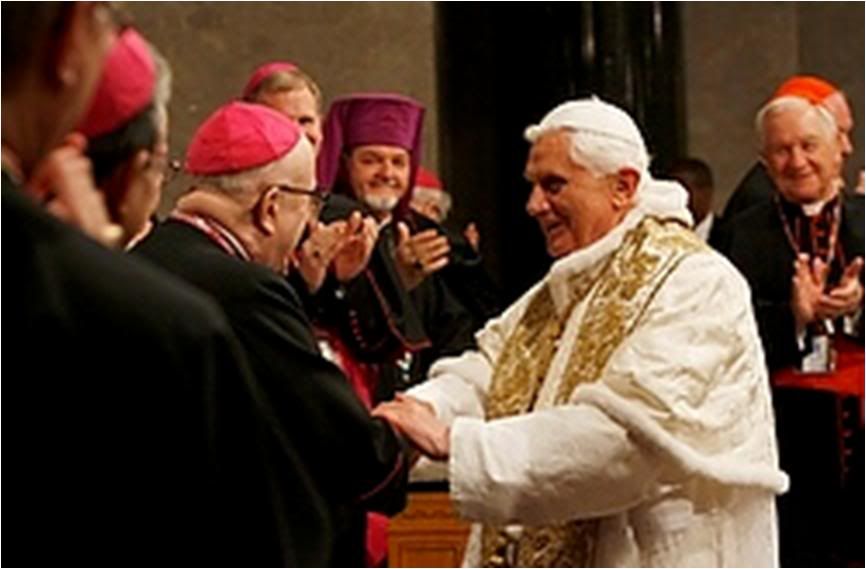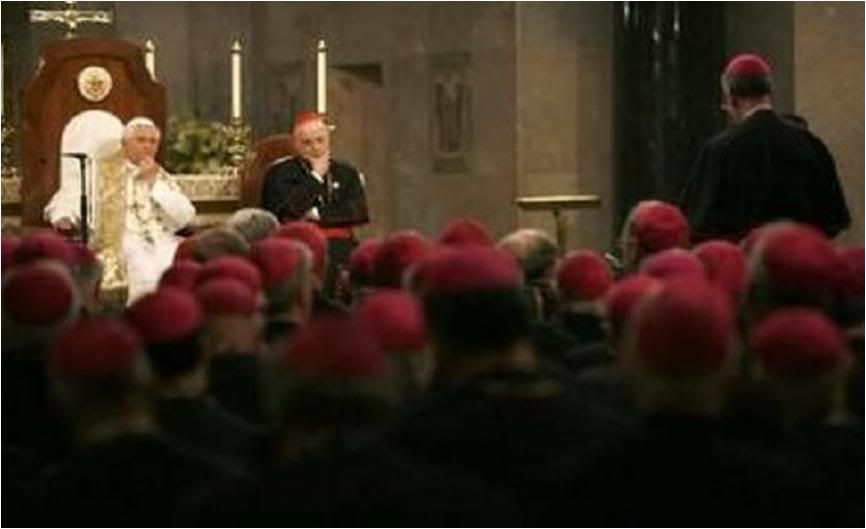
 A surprising item from America magazine and particularly from thw writer who in the past year has produced a number of clunkers andpratfalls much fisked in the Catholic 'orthodox' blogosphere. Though the title is rather clunky itself and infelicitous even if it is meant to be positive.... Why not just say 'The luminosity of Pope Benedict', for instance?... Still, I am thankful to Mr. Winters for having had this insight!
The anti-shadow of Pope Benedict
A surprising item from America magazine and particularly from thw writer who in the past year has produced a number of clunkers andpratfalls much fisked in the Catholic 'orthodox' blogosphere. Though the title is rather clunky itself and infelicitous even if it is meant to be positive.... Why not just say 'The luminosity of Pope Benedict', for instance?... Still, I am thankful to Mr. Winters for having had this insight!
The anti-shadow of Pope Benedict
BY Michael Sean Winters

Nov. 17, 2009
 Pope Benedict with the US bishops in Washington DC last April 2005.
Pope Benedict with the US bishops in Washington DC last April 2005.
The shadow of Pope Benedict XVI was everywhere apparent at the first day of the USCCB meeting. Except that it is not a shadow at all. A shadow obscures the light, making it more difficult to see.
The dominant theme of the meeting so far is entirely positive, echoing
the Holy Father’s insistence that the Church must proclaim what it is for, not just what it is against.
The opening sentences of the bishops’ statement on the health care reform debate read, "The US House of Representatives advanced major legislation to provide adequate and affordable health care to all. The Catholic Bishops of the United States have long advocated that adequate health care be made available to everyone."
They go on to voice their continued concern that health care reform not be used to extend abortion coverage, and they seem confidant that thevictory they achieved in the House can survive in the Senate.
In his presidential address, Cardinal Francis George said, "Relations do not speak first of control but of love. If there is a loosening of relationship between ourselves and those whom Christ has given us to govern in love, it is for us to reach out and re-establish conditions necessary for all to remain in communion."
In his address to the bishops, papal nuncio Archbishop Peitro Sambi reiterated the need for the Church to articulate a positive, compelling vision for the flock and for the broader culture.
Father David O’Connell, the President of the Catholic University of America, gave his last address to the bishops as president of their university: O’Connell earlier announced that he is stepping down as president of the bishops’ own university next summer.
Nowhere is the need to articulate a positive vision for the Church in the culture more evident than at a Catholic University, and few university administrators have done more than O’Connell to meet that need.
During O’Connell’s tenure, CUA focused on the Catholic identity of the institution. He has sponsored a variety of symposia, including one last month commemorating the "Year for Priests," the only such university symposium on the subject in America. He revamped the campus chaplaincy, making it a more integral part of campus life.
O’Connell kept a tight rein on the extension of invitations to outside speakers, shunning any who disagreed publicly with the Church’s core teachings, avoiding the kind of controversies that usually shed more darkness than light on the role of the Church in society.
On the other hand, he was frequently targeted by right wing critics for sponsoring such cultural events as a performance of Leonard Bernstein’s rock opera "Mass." But, if a Catholic University is not the right and proper place at which to perform such cultural gems, what is?
The shadow under which the Church in America has labored for too long is the negative view of human nature and, consequently, of human culture, that is a hallmark of Calvinism.
The Catholic Church has always fluctuated between adapting cultural norms and finding its own Catholic identity.
Pope Benedict XVI has invited the Church to see its role differently from that of a scold. At the meeting this week in Baltimore, his invitation has been accepted.

[Modificato da TERESA BENEDETTA 18/11/2009 01:04]